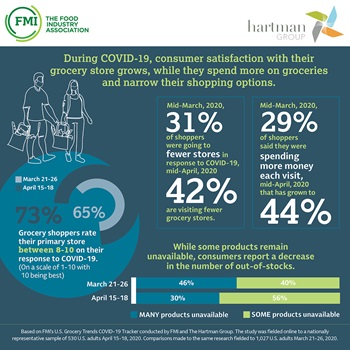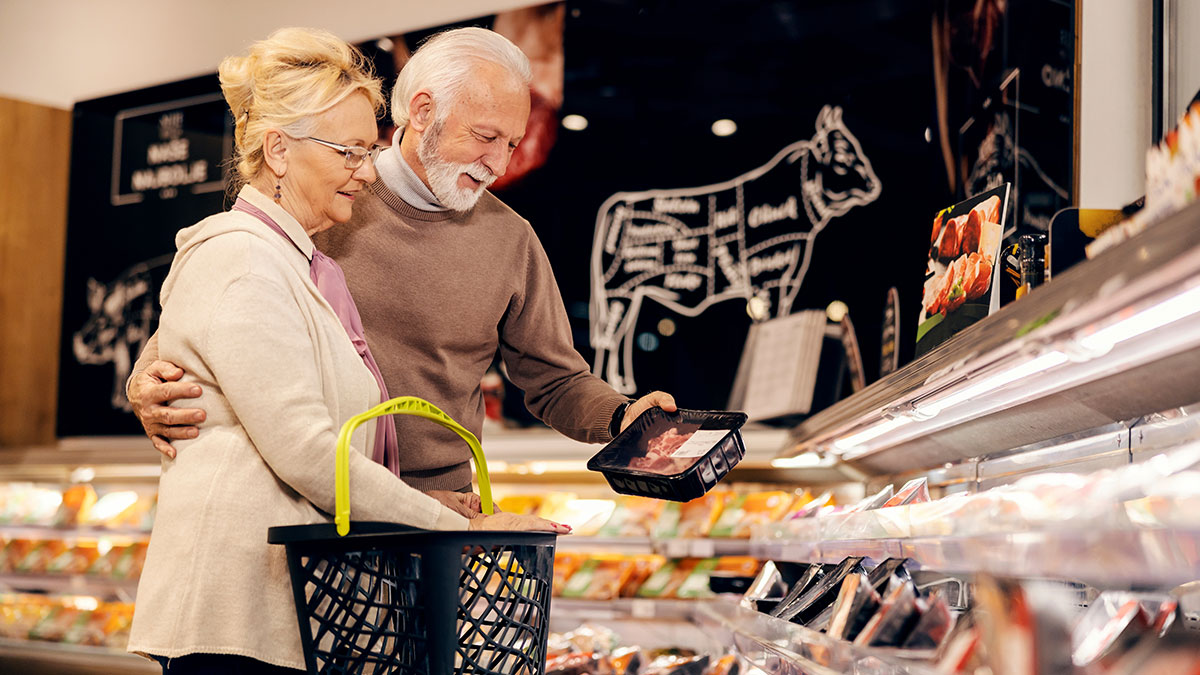By Steve Markenson, Director, Research, FMI
March 7, 2020 was a beautiful Saturday afternoon. My wife and I jumped in the car for a relaxing afternoon doing our weekly grocery shopping. We started at a club store for our bulk purchases, proceeded to a specialty grocer for some unique products that we like and then completed our adventure at a traditional grocery store. Fast forward five weeks and our grocery shopping has completely changed. As Americans continue to cope with new realities presented by the COVID-19 pandemic, we are not alone as grocery shopping has shifted dramatically. As I look each week at the results of our U.S. Grocery Shopper Trends COVID-19 tracking surveys of consumers, I see my own household.
relaxing afternoon doing our weekly grocery shopping. We started at a club store for our bulk purchases, proceeded to a specialty grocer for some unique products that we like and then completed our adventure at a traditional grocery store. Fast forward five weeks and our grocery shopping has completely changed. As Americans continue to cope with new realities presented by the COVID-19 pandemic, we are not alone as grocery shopping has shifted dramatically. As I look each week at the results of our U.S. Grocery Shopper Trends COVID-19 tracking surveys of consumers, I see my own household.
We now put more effort in planning our grocery shopping trips
Before we leave the house, most of us are now planning our grocery shopping by checking which staples and supplies need replenishing (88%) and making a shopping list (83%). Many of us, including me, are getting input from others in the household (60%) and making more of an effort to plan out meals (69%). While we used to do some of this before, these are all more common now than before the COVID-19 pandemic.
We now shop fewer places
What used to be a relaxing outing for my wife and me is now a one-person operation, as is the case for many households. We, like most shoppers (79%), have adjusted where we shop. We are shopping at fewer stores (36%), avoiding stores we used to go to (15%), changing where we shop at most frequently (10%) and relying on stores we did not previously (10%). We used to be like the average U.S. grocery shopper who visited 4.4 food retailers per month, but that is not the case during this current pandemic. We are trying to get all we need from just one or two stores to limit our exposure.
We have discovered online grocery shopping, for better or worse
My wife has discovered online grocery shopping in our effort to practice social distancing and as a way to overcome her concerns about running out of that valuable commodity, toilet paper. Many shoppers are shopping online for the first time (20%), while those who previously shopped online are increasing their usage. However, our online experience has been frustrated by out-of-stocks, delivery delays, mistakes in orders and other issues. It seems that we are not alone, as 84% of online shoppers who placed or attempted to place an order last week had some type of issue. The online grocery shopping experience we have had has resulted in our return to in-store shopping. How will these experiences impact grocery shopping behaviors in the future?
We appreciate our grocery store as they are doing all they can to keep the shelves stocked
Being part of the industry, I may be biased. But I see many Americans are giving their grocery stores high marks for their efforts during this pandemic. In fact, shoppers’ ratings of their grocery stores have increased from the first week of our surveys (65%) until this past week (73%). In addition, while there are some products unavailable, we are seeing less shoppers reporting many out-of-stocks each week (initially 46% down to 30% last week).
To learn more, visit our U.S. Grocery Shoppers Trends COVID-19 tracking survey web page and join us for a webinar on May 7th. FMI will be continuing to track consumer attitudes and perceptions over the coming weeks. Stay tuned for more insights from the shoppers’ perspective.


 Industry Topics address your specific area of expertise with resources, reports, events and more.
Industry Topics address your specific area of expertise with resources, reports, events and more.
 Our Research covers consumer behavior and retail operation benchmarks so you can make informed business decisions.
Our Research covers consumer behavior and retail operation benchmarks so you can make informed business decisions.
 Events and Education including online and in-person help you advance your food retail career.
Events and Education including online and in-person help you advance your food retail career.
 Food Safety training, resources and guidance that help you create a company food safety culture.
Food Safety training, resources and guidance that help you create a company food safety culture.
 Government Affairs work — federal and state — on the latest food industry policy, regulatory and legislative issues.
Government Affairs work — federal and state — on the latest food industry policy, regulatory and legislative issues.
 Get Involved. From industry awards to newsletters and committees, these resources help you take advantage of your membership.
Get Involved. From industry awards to newsletters and committees, these resources help you take advantage of your membership.
 Best practices, guidance documents, infographics, signage and more for the food industry on the COVID-19 pandemic.
Best practices, guidance documents, infographics, signage and more for the food industry on the COVID-19 pandemic.
